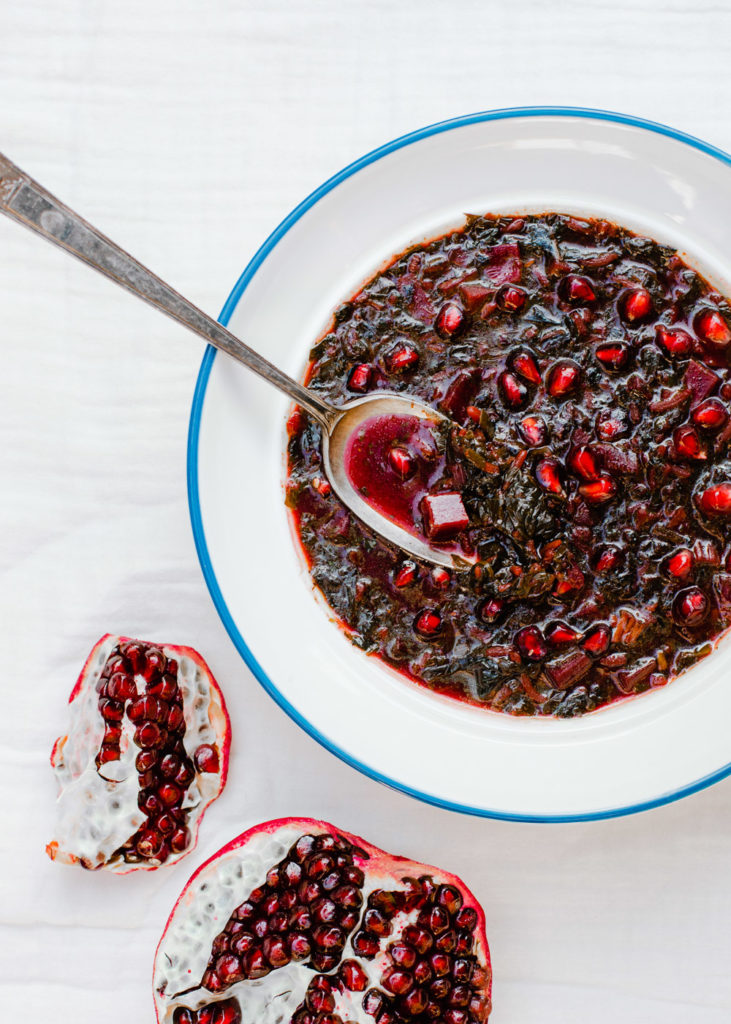
Ash-e Anar
Yield: 12 to 14 servings
Shab-e Yalda is the longest night of the year and the start of the Iranian winter solstice festival. On this evening, families gather to eat, drink, and read poetry by the Persian poet Hafez. Ash-e anar symbolizes abundance, with pomegranates representing the abundance of blessings, and crimson food the dawn and glow of life.
Ash-e anar varies from region to region. My family is from Tehran, and mom has improvised a bit over the years on this recipe, which is hers, while keeping it both classic and soulful. If you wish to add protein and make the soup a bit heartier, you can make and add tiny meatballs seasoned with salt, pepper and caramelized onion.
Also, the soup is even better the next day!
This recipe was published in The Tradition Issue of Life & Thyme Post, our quarterly newspaper shipping exclusively to L&T members. Get your copy.
Ingredients
- 2 bunches parsley
- 2 bunches cilantro
- 2 bunches spinach
- ½ cup avocado oil
- 1 large onion, medium dice
- 6 large garlic cloves, roughly chopped
- 2 bunches of medium-sized beets, including beet tops
- 1 to 2 tbsp. salt
- 1 tsp. fresh black pepper
- 1 tsp. turmeric
- 1 cup basmati rice
- 32 oz. pure pomegranate juice (not from concentrate, no added sugar)
- 10 oz. pomegranate molasses
- About 3 quarts of water
Missing ingredients? We got you.
Find and support independent producers, farmers and purveyors in your local area with our crowdsourced directory, Supply Home Cooks.
Method
- Before starting this soup, it is important to give yourself enough time to thoroughly wash, pick and cut the herbs, and then finely chop them. Do this with the parsley, cilantro and spinach, as well as with the beet tops. Peel and dice the beets in a medium dice or matchsticks set aside.
- In a clean bowl, add your basmati rice. Gently stream cold water over the rice using your hands to softly swirl all the starch out. Drain the water and repeat twice. Set aside.
- In a large pot (about 16 quarts) over medium-low heat, add the avocado oil and onion. Allow the onion to sweat for about 8 minutes, just enough to gently cook the onions.
- Add the cut beets to the onion, followed by salt, pepper, turmeric, and then rice. Stir and cook for a minute, then add about 3 quarts of water. Cook with a lid, stirring every 7 minutes or so to make sure the rice isn’t sticking to the bottom of the pot. It should take about 20 minutes for the beets and rice to get to their desired texture. To see if the rice is cooked, squeeze a kernel or two between your thumb and forefinger; it should be soft, but not mushy.
- Add the pomegranate juice, beet tops, cilantro, parsley and spinach. Stir and cook for 10 minutes. Finally, add the pomegranate molasses and allow to simmer on low for 1 hour, making sure to stir consistently.
- Add salt to taste. Optionally, garnish with pomegranate seeds.






Our comments section is for members only.
Join today to gain exclusive access.